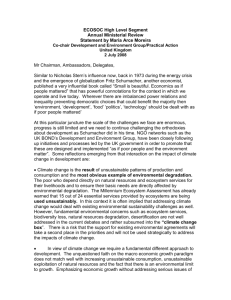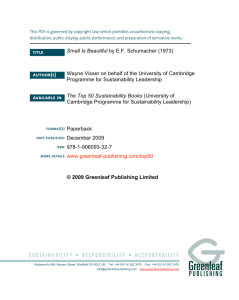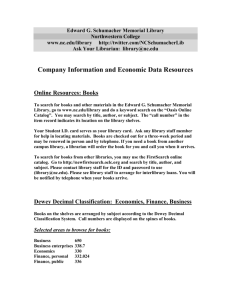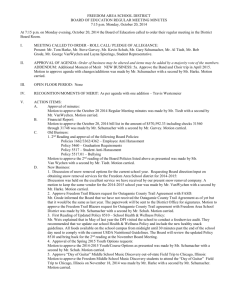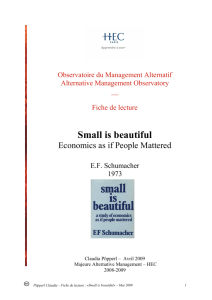The Schumacher Enigma Revisited
advertisement
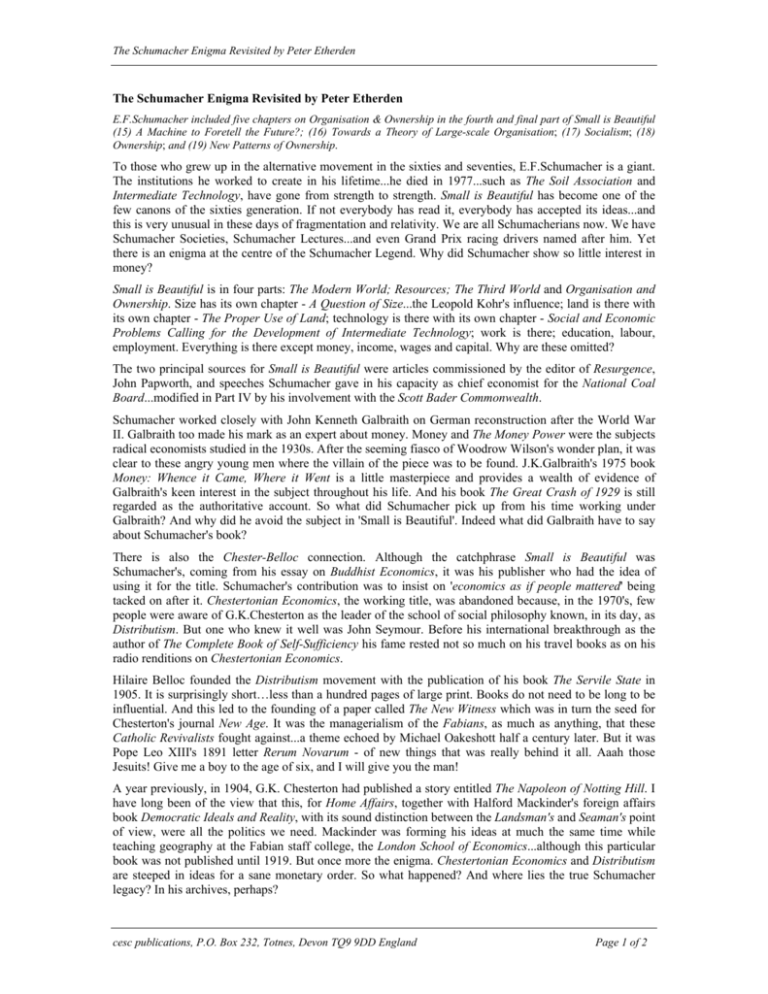
The Schumacher Enigma Revisited by Peter Etherden The Schumacher Enigma Revisited by Peter Etherden E.F.Schumacher included five chapters on Organisation & Ownership in the fourth and final part of Small is Beautiful (15) A Machine to Foretell the Future?; (16) Towards a Theory of Large-scale Organisation; (17) Socialism; (18) Ownership; and (19) New Patterns of Ownership. To those who grew up in the alternative movement in the sixties and seventies, E.F.Schumacher is a giant. The institutions he worked to create in his lifetime...he died in 1977...such as The Soil Association and Intermediate Technology, have gone from strength to strength. Small is Beautiful has become one of the few canons of the sixties generation. If not everybody has read it, everybody has accepted its ideas...and this is very unusual in these days of fragmentation and relativity. We are all Schumacherians now. We have Schumacher Societies, Schumacher Lectures...and even Grand Prix racing drivers named after him. Yet there is an enigma at the centre of the Schumacher Legend. Why did Schumacher show so little interest in money? Small is Beautiful is in four parts: The Modern World; Resources; The Third World and Organisation and Ownership. Size has its own chapter - A Question of Size...the Leopold Kohr's influence; land is there with its own chapter - The Proper Use of Land; technology is there with its own chapter - Social and Economic Problems Calling for the Development of Intermediate Technology; work is there; education, labour, employment. Everything is there except money, income, wages and capital. Why are these omitted? The two principal sources for Small is Beautiful were articles commissioned by the editor of Resurgence, John Papworth, and speeches Schumacher gave in his capacity as chief economist for the National Coal Board...modified in Part IV by his involvement with the Scott Bader Commonwealth. Schumacher worked closely with John Kenneth Galbraith on German reconstruction after the World War II. Galbraith too made his mark as an expert about money. Money and The Money Power were the subjects radical economists studied in the 1930s. After the seeming fiasco of Woodrow Wilson's wonder plan, it was clear to these angry young men where the villain of the piece was to be found. J.K.Galbraith's 1975 book Money: Whence it Came, Where it Went is a little masterpiece and provides a wealth of evidence of Galbraith's keen interest in the subject throughout his life. And his book The Great Crash of 1929 is still regarded as the authoritative account. So what did Schumacher pick up from his time working under Galbraith? And why did he avoid the subject in 'Small is Beautiful'. Indeed what did Galbraith have to say about Schumacher's book? There is also the Chester-Belloc connection. Although the catchphrase Small is Beautiful was Schumacher's, coming from his essay on Buddhist Economics, it was his publisher who had the idea of using it for the title. Schumacher's contribution was to insist on 'economics as if people mattered' being tacked on after it. Chestertonian Economics, the working title, was abandoned because, in the 1970's, few people were aware of G.K.Chesterton as the leader of the school of social philosophy known, in its day, as Distributism. But one who knew it well was John Seymour. Before his international breakthrough as the author of The Complete Book of Self-Sufficiency his fame rested not so much on his travel books as on his radio renditions on Chestertonian Economics. Hilaire Belloc founded the Distributism movement with the publication of his book The Servile State in 1905. It is surprisingly short…less than a hundred pages of large print. Books do not need to be long to be influential. And this led to the founding of a paper called The New Witness which was in turn the seed for Chesterton's journal New Age. It was the managerialism of the Fabians, as much as anything, that these Catholic Revivalists fought against...a theme echoed by Michael Oakeshott half a century later. But it was Pope Leo XIII's 1891 letter Rerum Novarum - of new things that was really behind it all. Aaah those Jesuits! Give me a boy to the age of six, and I will give you the man! A year previously, in 1904, G.K. Chesterton had published a story entitled The Napoleon of Notting Hill. I have long been of the view that this, for Home Affairs, together with Halford Mackinder's foreign affairs book Democratic Ideals and Reality, with its sound distinction between the Landsman's and Seaman's point of view, were all the politics we need. Mackinder was forming his ideas at much the same time while teaching geography at the Fabian staff college, the London School of Economics...although this particular book was not published until 1919. But once more the enigma. Chestertonian Economics and Distributism are steeped in ideas for a sane monetary order. So what happened? And where lies the true Schumacher legacy? In his archives, perhaps? cesc publications, P.O. Box 232, Totnes, Devon TQ9 9DD England Page 1 of 2 The Schumacher Enigma Revisited by Peter Etherden The above text has been extracted from an article written ten years ago and first published in Fourth World Review Number 93 in February 1999 as The Schumacher Enigma. The remarks are correct as far as they go...but they do not go far enough. Schumacher was a generation ahead of the game. There is a lot more about money in Small is Beautiful than meets the eye. But it is deeply embedded behind concepts like justice, wealth, ownership and charity. In the 1880s G.B. Shaw argued in The Fabian Papers that Socialism is equal money and that money and capital derived their meaning and value as personal possessions, private property and common wealth. Public versus private was a rhetorical trap. R.H.Tawney developed the analysis for the 1947 Labour Government of Clement Attlee, Herbert Morrison, Hugh Dalton and Ernest Bevin by discriminating between Property and Improperty. The cancer eating away at the heart of our civilization was passive property allied to the limited liability of the joint stock company. 'In earlier ages,' wrote Tawney, 'the protection of property was normally the protection of work [but] the relationship between them has come in the course of the economic development of the last two centuries to be very nearly reversed.' Tawney saw very clearly the 'constant collision [between] active efforts and passive property, the labour of human beings and the tools which human beings use. Of these two elements those who supply the first maintain and improve it, those who own the second normally dictate its character, its development, and its administration'. These remarks were taken from an article entitled The Tawney Legacy, written in 2000 and first published in Fourth World Review Number 121/122 in June 2001.1 Schumacher's insight was in realising that underpinning Shaw's ideas of equal money and Tawney's thinking on improperty lay the doctrines of the Christian Churches and their concerns with justice and charity. The fourth and final part of Small is Beautiful...entitled Organisation & Ownership...addresses these deeper issues. There are five chapters: (15) A Machine to Foretell the Future?; (16) Towards a Theory of Large-scale Organisation; (17) Socialism; (18) Ownership; and (19) New Patterns of Ownership. 1 Peter Etherden's Work and Human Fulfilment workshop at the Radical Consultation in September 2001 included nine papers; The Duke of Buen Consejo by Leopold Kohr (1964); Large-scale Organisation by E.F.Schumacher (1972); The Scott Bader Commonwealth by E.F.Schumacher (1972); Beauty & Community by Leopold Kohr (1973); TeaTime at Marshbeck by James Robertson (1983); The Future for Large Organisations by Peter Etherden (1989); The Foundations of Structural Sociology by William Shepherd (2000); Mind Your Own Business by Chris Wright (2001); Limited Life Organisations by Shann Turnbull (2001). The two Schumacher papers were taken from chapters 16 and 19 in the Organisation and Ownership part of Small is Beautiful: Economics as if People Mattered (1973). cesc publications, P.O. Box 232, Totnes, Devon TQ9 9DD England Page 2 of 2
